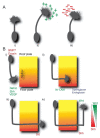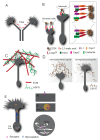Glycosylation in Axonal Guidance
- PMID: 34068002
- PMCID: PMC8152249
- DOI: 10.3390/ijms22105143
Glycosylation in Axonal Guidance
Abstract
How millions of axons navigate accurately toward synaptic targets during development is a long-standing question. Over decades, multiple studies have enriched our understanding of axonal pathfinding with discoveries of guidance molecules and morphogens, their receptors, and downstream signalling mechanisms. Interestingly, classification of attractive and repulsive cues can be fluid, as single guidance cues can act as both. Similarly, guidance cues can be secreted, chemotactic cues or anchored, adhesive cues. How a limited set of guidance cues generate the diversity of axonal guidance responses is not completely understood. Differential expression and surface localization of receptors, as well as crosstalk and spatiotemporal patterning of guidance cues, are extensively studied mechanisms that diversify axon guidance pathways. Posttranslational modification is a common, yet understudied mechanism of diversifying protein functions. Many proteins in axonal guidance pathways are glycoproteins and how glycosylation modulates their function to regulate axonal motility and guidance is an emerging field. In this review, we discuss major classes of glycosylation and their functions in axonal pathfinding. The glycosylation of guidance cues and guidance receptors and their functional implications in axonal outgrowth and pathfinding are discussed. New insights into current challenges and future perspectives of glycosylation pathways in neuronal development are discussed.
Keywords: attraction; axonal guidance; chemotaxis; chondroitin sulfate; glycosaminoglycan; glycosylation; haptotaxis; heparan sulfate proteoglycan; hyaluronan; repulsion.
Conflict of interest statement
The authors declare no conflict of interest.
Figures



Similar articles
-
Permissive and repulsive cues and signalling pathways of axonal outgrowth and regeneration.Int Rev Cell Mol Biol. 2008;267:125-81. doi: 10.1016/S1937-6448(08)00603-5. Int Rev Cell Mol Biol. 2008. PMID: 18544498 Review.
-
Netrin, Slit and Wnt receptors allow axons to choose the axis of migration.Dev Biol. 2008 Nov 15;323(2):143-51. doi: 10.1016/j.ydbio.2008.08.027. Epub 2008 Sep 5. Dev Biol. 2008. PMID: 18801355 Review.
-
Subrepellent doses of Slit1 promote Netrin-1 chemotactic responses in subsets of axons.Neural Dev. 2015 Mar 20;10:5. doi: 10.1186/s13064-015-0036-8. Neural Dev. 2015. PMID: 25888985 Free PMC article.
-
Uncoupling of UNC5C with Polymerized TUBB3 in Microtubules Mediates Netrin-1 Repulsion.J Neurosci. 2017 Jun 7;37(23):5620-5633. doi: 10.1523/JNEUROSCI.2617-16.2017. Epub 2017 May 8. J Neurosci. 2017. PMID: 28483977 Free PMC article.
-
Novel brain wiring functions for classical morphogens: a role as graded positional cues in axon guidance.Development. 2005 May;132(10):2251-62. doi: 10.1242/dev.01830. Development. 2005. PMID: 15857918 Review.
Cited by
-
Molecular logic for cellular specializations that initiate the auditory parallel processing pathways.Nat Commun. 2025 Jan 9;16(1):489. doi: 10.1038/s41467-024-55257-z. Nat Commun. 2025. PMID: 39788966 Free PMC article.
-
Molecular logic for cellular specializations that initiate the auditory parallel processing pathways.bioRxiv [Preprint]. 2024 Oct 6:2023.05.15.539065. doi: 10.1101/2023.05.15.539065. bioRxiv. 2024. Update in: Nat Commun. 2025 Jan 9;16(1):489. doi: 10.1038/s41467-024-55257-z. PMID: 37293040 Free PMC article. Updated. Preprint.
-
Altered expression of glycan patterns and glycan-related genes in the medial prefrontal cortex of the valproic acid rat model of autism.Front Cell Neurosci. 2022 Dec 8;16:1057857. doi: 10.3389/fncel.2022.1057857. eCollection 2022. Front Cell Neurosci. 2022. PMID: 36568890 Free PMC article.
-
Structure and evolution of neuronal wiring receptors and ligands.Dev Dyn. 2023 Jan;252(1):27-60. doi: 10.1002/dvdy.512. Epub 2022 Jul 6. Dev Dyn. 2023. PMID: 35727136 Free PMC article. Review.
-
Glycans and Carbohydrate-Binding/Transforming Proteins in Axon Physiology.Adv Neurobiol. 2023;29:185-217. doi: 10.1007/978-3-031-12390-0_7. Adv Neurobiol. 2023. PMID: 36255676
References
Publication types
MeSH terms
Substances
Grants and funding
LinkOut - more resources
Full Text Sources

